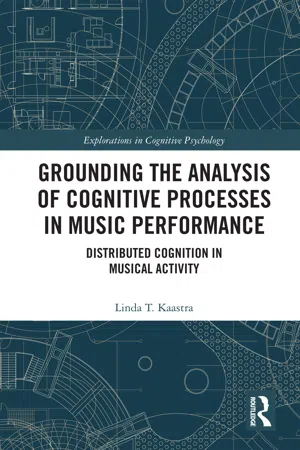
Grounding the Analysis of Cognitive Processes in Music Performance
Distributed Cognition in Musical Activity
- 164 pages
- English
- ePUB (mobile friendly)
- Available on iOS & Android
Grounding the Analysis of Cognitive Processes in Music Performance
Distributed Cognition in Musical Activity
About this book
Through the systematic analysis of data from music rehearsals, lessons, and performances, this book develops a new conceptual framework for studying cognitive processes in musical activity.
Grounding the Analysis of Cognitive Processes in Music Performance draws uniquely on dominant paradigms from the fields of cognitive science, ethnography, anthropology, psychology, and psycholinguistics to develop an ecologically valid framework for the analysis of cognitive processes during musical activity. By presenting a close analysis of activities including instrumental performance on the bassoon, lessons on the guitar, and a group rehearsal, chapters provide new insights into the person/instrument system, the musician's use of informational resources, and the organization of perceptual experience during musical performance. Engaging in musical activity is shown to be a highly dynamic and collaborative process invoking tacit knowledge and coordination as musicians identify targets of focal awareness for themselves, their colleagues, and their students.
Written by a cognitive scientist and classically trained bassoonist, this specialist text builds on two decades of music performance research; and will be of interest to researchers, academics, and postgraduate students in the fields of cognitive psychology and music psychology, as well as musicology, ethnomusicology, music theory, and performance science.
Linda T. Kaastra has taught courses in cognitive science, music, and discourse studies at the University of British Columbia (UBC) and Simon Fraser University. She earned a PhD from UBC's Individual Interdisciplinary Graduate Studies Program.
Frequently asked questions
- Essential is ideal for learners and professionals who enjoy exploring a wide range of subjects. Access the Essential Library with 800,000+ trusted titles and best-sellers across business, personal growth, and the humanities. Includes unlimited reading time and Standard Read Aloud voice.
- Complete: Perfect for advanced learners and researchers needing full, unrestricted access. Unlock 1.4M+ books across hundreds of subjects, including academic and specialized titles. The Complete Plan also includes advanced features like Premium Read Aloud and Research Assistant.
Please note we cannot support devices running on iOS 13 and Android 7 or earlier. Learn more about using the app.
Information
Part I
Musical Thought on the Bassoon
1Ecological Foundations
| Basic Cues | Fingerings | Technical difficulties | Familiar patterns |
| Interpretive Cues | Phrasing | Dynamics | Tempi |
| Performance Cues | Basic | Interpretive | Expressive |
Musical Activities
- Bassoonist A is in a practice room sitting in a chair, looking at a music stand that has a tuner on it. They play a series of long tones, scales, and intervals while looking at the tuner to calibrate their pitch to A = 440.
- Bassoonist B sits in the second chair of the symphony orchestra, holding a low C while the conductor adds members of the wind section, one by one, to build a polychord, a mix of notes from two different chords.
- Bassoonist C is standing backstage before a recital, swaying slightly, eyes closed, head moving, fingers twitching on the instrument.
- Bassoonist D is in a dressing room of a concert hall in a major city, sitting in front of a lighted mirror. After sitting in rest position for a few minutes, they assume performance position, run through the orchestral excerpt for the “Overture” to The Marriage of Figaro, and then go back to rest position.
What Is a Representation?
Table of contents
- Cover
- Half Title
- Series
- Title
- Copyright
- Dedication
- Contents
- List of Figures
- About the Author
- Acknowledgments
- Preface
- Introduction—What Is Music?
- Part I Musical Thought on the Bassoon
- Part II Representation
- Part III Conceptualizing Ensemble Performance
- Index